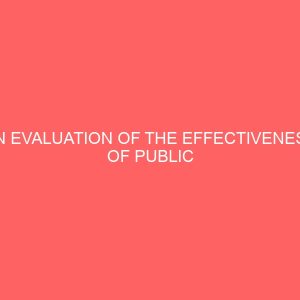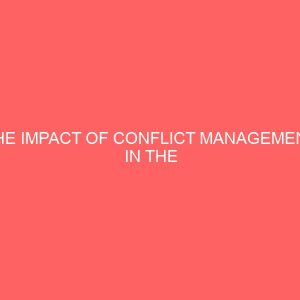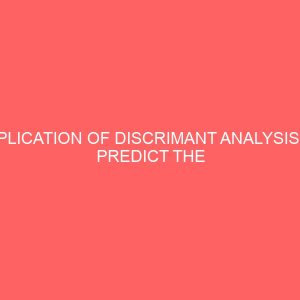Description
CHAPTER ONE
INTRODUCTION
1.1 BACKGROUND OF THE STUDY
This project is on an evaluation of the effectiveness of public relations strategies employed during the Moshood Abiola Polytechnic conversion crises. Over the years, major tertiary institutions in Nigeria have been facing one crisis or the other with their internal publics (students, staffs), often leading to industrial disharmony, demonstrations and closedown of facilities. This has sometimes raised some question marks on the public relations crisis management strategies in reference to the conversion crises that rocked the Moshood Abiola Polytechnic, Abeokuta few years ago.
Without equivocation, the British Institute of Public Relations (BIPR) defines public relations as the deliberate, planned and sustained effort to establish and maintain mutual understanding between an organization and its publics (Yaroson & Asemah, 2007). It is a process that must be deliberately planned, carefully implemented and assiduously monitored to achieve a given goal or objective, targeted mainly at building and sustaining mutual understanding between an organization and its publics (Onwunali et al, 2006). Every organization has both internal and external publics with whom mutual understanding must be nurtured and maintained for the growth of the organization. It is the duty of the corporate communications or public relations manager to professionally ensure that public relations serves as an intermediary between the organization that he or she represents and all its publics (Meintjes, 2011). One of the critical areas of his/her duty is issues and crisis management, without which the organisation could be blown down one day.
Issues management in public relations practice is the proactive monitoring and resolving of simmering issues with negative potentials before they balloon into crisis (Odigbo et al., 2013). On the other hand, crisis management is the coordinated effort to handle effects of unfavorable publicity and ensuring fast and accurate communication in times of emergency (Uduji, 2012). It involves the communications management function used to convey accurate facts and data to the general public and to specific publics during a crisis situation in order to minimize negative publicity that could adversely affect the success of the organization/company. It involves identifying crisis, planning a response to the crisis and confronting and resolving the crisis. Crisis Management can be applied in almost any field of endeavour, but it is most commonly used in international relations, political sciences, business and management (Coombs, 2007).
Today’s business World has become very competitive. To survive in this ever-changing and ever- challenging business environment requires the recognition, as well as, acceptance of public relations crisis communication tools as vital weapons in the hands of all organizations in all modern societies (Asemah, 2011). The Mexican Statement 1978, as stated in Uduji (2012), must have borne crisis management in mind when it defined public relations practice as “the art and social science of analyzing trends, predicting their consequences, counseling organization leaders and implementing planned programs of actions which will serve both the organization’s and the public interest.” In this very definition, “analyzing trends, predicting their consequences and counseling organization leaders” entails proactive crisis management approach.
A crisis can be defined as an incident or event with consequences, which pose a significant threat to the strategic objectives of an organization (Hale et al., 2005). These include downsizing, corporate lawsuits, negative media coverage, government probes, insurgency, political crisis, quality problems, product recalls, boycotts, and strikes. Crisis Management works to minimize all these and the consequent damage to a company’s reputation. At the same time, it tries to take advantage of any benefits that can be obtained from crisis (Bernstein & Rakowitz, 2012). It includes communication that occurs with response phase of emergency management methods of a business or an organization (Hazarika, 2013).
Importantly, the fact that the practice of Public Relations was formerly repositioned, regularized, standardized and given legal status by the Federal Government of Nigeria through the instrument of Decree 16 of 1990 (now an Act of the National Assembly) further enhanced the relevance and recognition of Public Relations by management of higher institutionss in the management of crises. This gave higher institutions the assurances to confidently include public relations units in the organizational structure of the respective institutions. Osuji in Salau (2001:56) observes too that, before the explosion of tertiary institutions in the country, and their mounting problems, in Nigeria did not have public relations departments. The importance of public relations as a management function was also not much recognized in the past. However, as Salau (2001:24) observes, “the mounting challenges facing Nigerian higher institutions and prevalence of crisis of various ramifications have compelled managers of these institutions to recognize, acknowledge and appreciate the importance of public relations.”
This, as observed by Osuji in Salau (2001:44) has made management of Nigerian higher institutions to evolve a deliberate policy of putting in place Public Relations Units, known in most Nigerian Higher institutions by different appellations such as Information and Publicity Units, Protocol and Information, Publicity and Protocol, etc.
It is therefore quite clear that, managers of educational institutions generally and higher institutions in particular in Nigeria, have to contend with many challenges as well as the expectations and demands of their publics. These expectations sometimes overlap and create serious challenges to the competency of the managers making it an arduous task for them in getting their positions across to their publics. As Salau (2001:57) notes, “the trade unions in these institutions are usually very militant in their legitimate demands.”
Unfortunately, the managers of these higher institutions are sometimes constrained in meeting the demands of their publics by circumstances beyond their control. Sometimes, government does not release funds to even pay salaries, leaving the Chief Executives with the choice of scouting for funds from other sources or facing vote of no confidence or strike threats by the employees. It is to help contend with these challenges which are the main causes of crises on Nigerian campuses that public relations has secured a place of significance in these institutions.
In some higher institutions, the public relations or information unit as it varies from institutions is located in the office of the Chief Executive Officers, Vice Chancellors, while in others it is located in the office of the Registrar, who is the administrative head of such institutions. It is in this light that Derriman and Pulay
(1979:49) regard the public relations personnel as bridge builders. According to them, “the public relations practitioner is a bridge builder. He builds first a bridge of understanding between his client or employer and those groups of people upon whom the policies and actions of the client or employer infringe. The public relations man then uses that bridge of acceptance and goodwill to the advantage of both.
Several issues and reasons have been adduced as causes of the crises in Nigerian higher institutions. These would be subsumed into: funding of the system; autonomy and welfare – conditions of service and those within which teaching, learning and research take place. Primarily, the issue of funding has been said to be a major source of crises in Nigerian higher institutions. For instance, Ibukun (2009) reported that between 1987 and 1997, average expenditure on education by the Federal Government, as a percentage of the annual budget was 5.1%. Arikewuyo (2004) reports that since the return to democracy in Nigeria in 1999, the funding of education dropped to 1.81% in 2003. UNESCO (2000) reported that unlike Nigeria which spends an average of 1.1% of its GDP/GNP on education, other countries like Ghana spend 3.6%, Kenya 6.2% and Zimbabwe 9.5%.
Indeed, regrettably, the issue of autonomy and academic freedom has also continued to generate controversies that often lead to conflict and crises. There is little doubt that government has recognized that higher institutions require autonomy and that they have to begiven freedom regarding their internal organization and administration especially in areasof admission, appointment of staff and selection of research areas as well asdetermination of their course contents. On the contrary, excuses like conformity withnational goals are used to circumvent this autonomy which naturally breeds conflicts.
To curtail the incessant crises, university managements in Nigeria as Salau (2001:53)observes, are becoming increasingly aware of the importance of understanding what isgoing on in their environment and among their stakeholders. To this end, they employvarious mechanisms and methods for gathering information and communicating withboth internal and external stakeholders, making public relations a prominent and a necessary tool or strategy in the management of crises in the Nigerian higher institutions.
For the purpose of this study, a critical view shall be carried out to evaluate the various public relations strategies employed by the staffs of MAPOLY during the conversion crises. Without mincing words, the Moshood Abiola Polytechnic also known as MAPOLY is a tertiary learning institution in Abeokuta, Ogun state. It is named after Moshood Kashimawo Olawale Abiola, who was elected president of Nigeria but was prevented from assuming office. The institution which was established in 1980 experienced her most turbulent period within 2016/17 following the conversion of the institution into a university of science and technology by the then governor of the state, Senator Ibikunle Amosun.
Ahead of the conversion, the Moshood Abiola Polytechnic can be said to have had a record of a peaceful institution. Indeed, regrettably, series of strikes, social media bullying, protests and even prolonged academic calendar greeted the institution following the announcement by the state government. The announcement which was made at the institution’s 14th convocation was received by the entire polytechnic community with exhilaration until April, 2017 when the then state government inaugurated a transition committee headed by a former executive secretary of NUC, Professor Peter Okebukola. The then governor, Amosun had promised that the committee would be disbanded once the governing council of MAUSTECH was constituted.
The genesis of the crises instigated when the academic staff union of polytechnic of MAPOLY staged a protest over what they described as a threat to their job by the Okebukola-led committee. The reason was not unconnected to the fact that the committee had issued a directive to direct more than 250 lecturers in the institution to turn in their resignation letters and reapply. This directive irked ASUP members who took to the streets in solidarity songs, fetish objects to forestall entries into the school. Thus, the long strike MAPOLY would have came sometime in August, 2017.
However, it should be noted that the union during the crises embarked on certain PR efforts which involves engaging prominent people to intervene into the situation in a bid to foster reconciliation between them and the institution’s governing council. Gladly, the efforts yielded positively as the strike was suspended after four months following interventions and appeals by stakeholders in the state.
It is in the view of the foregoing that this research study has been instigated to look into the various PR strategies deployed by the members of the union in a bid to effectively manage the then crises. To actualize this, this study will carefully identify the strategies deployed and evaluate the effectiveness of each of those strategies.
1.2 STATEMENT OF THE PROBLEM
Without mincing words, the workers of MAPOLY employed various strategies to address and redress reputation, issues, challenges enveloped in the conversion crises that rocked the institution years back. However, it is usually said that for PR efforts to effectively manage crises, there must be open and consistent application of public relations strategies by all quarters involved.
Despite the fact that the strategies deployed was instrumental in the management of the crises, the question on how the public relations strategies were applied by workers of the institution as indispensable tools crises management on campus remains unanswered, hence the motivation for this study.
Conclusively, it should be recalled that PR crises management strategies are efforts which must be sustained to avert subsequent crises. However, there seems to be a problem of sustainability of the PR strategies deployed by the workers of this institution during the conversion crises, hence the instigation of this research to investigate the circumstances militating against the sustainability of the PR strategies. It should be noted that this is vital to maintain mutual understanding, acceptance, goodwill and trust between the management of the institution and the workers.
1.3 OBJECTIVE OF THE STUDY
The study intends to find out the various PR strategies deployed by the members of the union in a bid to effectively manage the then crises. In specific terms it intends to:
- To investigate if there is any significant relationship between PR strategies and crises management.
- To identify the types of public relations crisis management strategies employed by the workers of MAPOLY during the conversion crises.
- To appraise the effectiveness of the public relations crisis strategies employed by the workers of MAPOLY during the conversion crises.
- To investigate the circumstances which hindered the effectiveness of the PR strategies.
- To investigate the factors hindering the sustainability of the PR strategies.
- To identify ways of fostering the sustainability of those PR strategies
1.4 RESEARCH QUESTIONS
The following questions have been pegged for the purpose of this research effort:
- To what extent are those public relations crisis management strategies effective?
- What are the various public relations crisis management strategies employed by the workers of MAPOLY during the conversion crises?
- What are the circumstances which hindered the effectiveness of the PR strategies?
- What are the various ways of fostering the sustainability of those PR strategies?
1.5 SIGNIFICANCE OF THE STUDY
This study will enhance the practice of public relations crisis management strategies by Nigerian institutions, especially MAPOLY. To the body of knowledge, it is expected to contribute immensely to literature that will help in managing crisis in volatile tertiary institutions in Nigeria.
It is also expected that this research will help provide data and information to other scholars and students that would embark on researches about different aspects of public relations practices in the institution and other issues bugging the institution.
1.6 SCOPE OF THE STUDY
This research study is primarily centered on the evaluation of the PR strategies deployed by staffs of the Moshood Abiola Polytechnic during the conversion crises.
1.7 OPERATIONAL DEFINITION OF TERMS
The following are the selected operational terms which will be defined in this study
Crisis: Crisis here refers to a situation in which an institution is hit with disharmony. It is a situation of protest, demonstration, strike or rampage involving the university students or staff in the attempt to press home their grievances.
Crisis Management: This study conceives crisis management as the process of crisis detection, prevention and resolution in order to sustain the smooth operation of the university. It can also be considered as the total efforts put into effect to achieve harmony and free flow of activities or normalcy in the institution.
Public Relations: Public Relations here refer to the organized and corporate nexus between an institution and its numerous publics. The institution manages the relationship which exists between them while minimizing the possibility of conflict or crisis within the institution or between the institution and its host community.









Reviews
There are no reviews yet.